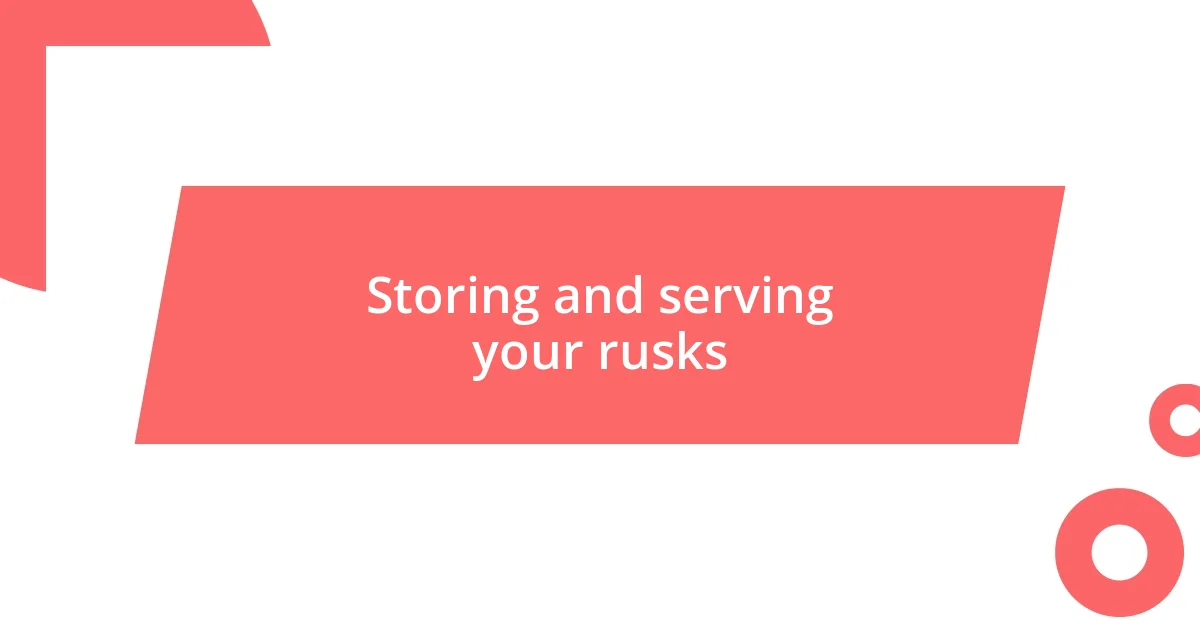Key takeaways:
- Each region has unique rusk recipes, highlighting cultural heritage with variations in ingredients and textures.
- Essential baking tools, like a digital kitchen scale and silicone mats, significantly enhance precision and ease in the baking process.
- Proper cooling and double-baking techniques are crucial for achieving the ideal crunch and flavor in rusks.

Introduction to baking rusks
Baking rusks is a delightful experience that connects you to tradition and flavor. I still remember the first time I pulled a batch of rusks from the oven; the aroma filled my kitchen, wrapping around me like a warm hug. The simple combination of flour, sugar, and butter transforms into something that not only satisfies hunger but also evokes memories of family gatherings and cheerful mornings spent sipping tea.
As I dove deeper into the process, I found myself fascinated by the cultural significance of rusks. Have you ever wondered why these humble treats hold a special place in so many hearts? For me, it was the discovery that each region had its own twist on the recipe, lending a unique touch that spoke volumes about its heritage. I was intrigued by how something so basic could stir up such profound connections, inviting you to share stories with every bite.
In preparing rusks, every step becomes a celebration of patience and care. I vividly recall the first time I experimented with flavors, adding a hint of cinnamon to one batch. The joy of taste-testing was unmatched—I felt a sense of accomplishment that made me eager to share my creation with loved ones. It’s fascinating how baking can encompass both skill and love, transforming simple ingredients into cherished memories.

Understanding traditional rusk recipes
Understanding traditional rusk recipes involves appreciating their rootedness in culture and tradition. I’ve noticed that while the core ingredients remain fairly consistent, each family seems to add its personal touch—like a pinch of nutmeg or a splash of vanilla. This variability is not just functional; it’s a lovely way for families to pass down memories and flavors through generations.
When diving into traditional rusk recipes, consider these key aspects:
- Ingredient Origins: Flour, sugar, and butter are staple items, but exploring local grains and natural sweeteners can alter your rusks considerably.
- Texture Techniques: Some recipes emphasize a crunchy or soft texture, depending on the baking time and moisture content.
- Cultural Variations: Different regions may use spices or herbs unique to their cuisine, transforming rusks into local delicacies.
- Baking Methods: I’ve found that using a double-bake method enhances the crispness, offering a satisfying crunch with every bite.
As I experimented, I found that even a small change—even something as simple as baking on a lower heat—could yield completely different results, making the process feel like a delicious adventure of personal discovery.

Gathering essential baking tools
Gathering essential baking tools is a crucial first step in my baking journey. Initially, I was overwhelmed by the myriad of options available, but I soon realized that a few key items could make all the difference. For instance, a sturdy mixing bowl and a reliable whisk are a must for blending ingredients seamlessly. I remember the first time I used a digital kitchen scale—it transformed my baking precision and really helped me nail the texture of the rusks.
As I progressed, I discovered that investing in quality tools pays off. My trusty silicone baking mats have significantly reduced the hassle of greasing pans, while ensuring an even bake. I often think back to the initial batches where I struggled with sticky dough, haphazardly coated pans, and inconsistent results. Now, these practical tools streamline my baking process, allowing me to focus on creating delicious treats rather than battling with equipment.
I can’t emphasize enough the importance of measuring cups and a kitchen timer. I once forgot to set my timer during a batch of rusks, leading to a rather burnt outcome. However, I’ve learned that having proper tools makes it easier to manage time and measurements effectively. It not only saves your rusks but also keeps the joy of baking intact.
| Tool | Purpose |
|---|---|
| Mixing Bowl | For combining ingredients |
| Whisk | For blending and aerating mixtures |
| Digital Kitchen Scale | For precise measurements |
| Silicone Baking Mat | For non-stick baking and easy cleanup |
| Measuring Cups | For accurately measuring dry and wet ingredients |
| Kitchen Timer | To ensure perfect baking times |

Preparing your rusk dough
Preparing your rusk dough is one of the most gratifying steps in the baking process. I often remember the first time I mixed flour and butter together; the texture felt like something magical forming in my hands. Achieving the right consistency is key—smooth yet slightly tacky. If your dough feels too dry or crumbly, don’t hesitate to add a splash of water or milk; it’s amazing how a little moisture can breathe life into your mixture.
Once you have the right dough, shaping it into logs is where creativity plays a role. I can still feel the warmth of the dough against my palms as I rolled it out during my early baking days. Even though it seems challenging, just remember there’s no need for precision; rustic shapes add character to your rusks. Isn’t it reassuring to know that the imperfections often lead to the most delightful outcomes?
Finally, don’t forget to let your dough rise appropriately before baking. Patience might be tough, but this step is crucial for developing that airy texture we all love. I recall my impatience with waiting during one of my first batches; I barely let the dough rest, and while the rusks turned out okay, they didn’t have that delightful crumb I was hoping for. Taking that extra time to rise can truly elevate your final product, transforming a simple treat into a cherished creation.

Perfecting the baking process
Perfecting the baking process is all about understanding the subtleties of temperature and timing. I vividly remember the first time I experimented with oven temperatures. I’d set it too high, eager to see my rusks rise, but it resulted in a burnt exterior and a doughy inside. It taught me an invaluable lesson: patience pays off. Now, I ensure my oven is preheated correctly, sticking to the recommended temperature, which has led to that delightful golden color I always strive for.
When it comes to baking time, I often engage in a bit of trial and error. I now rely on a visual cue that has served me well—watching for a slight rise and golden edges gives me confidence that my rusks are nearing perfection. One memorable batch, I was tempted to pull them out early, but I forced myself to wait just a few more minutes, and the aroma filled my kitchen, making the wait worthwhile. Have you ever experienced that moment when you almost jumped the gun but held off? It’s a game-changer!
Finally, let’s talk about the magic of cooling time. This step is often overlooked, yet it’s crucial. I used to slice into my rusks too soon, thinking more of my impatience than the flavors developing. The first time I allowed them to cool completely, I was blown away by how much the taste improved. The crunchiness I was after came through beautifully. I recommend giving your rusks at least 30 minutes to cool before diving in. Trust me, your taste buds will thank you later!

Tips for achieving ideal texture
Achieving the ideal texture in rusks is all about the right balance of ingredients and technique. One lesson that really struck me was about the quality of flour. I recall switching from regular all-purpose flour to a more finely milled one, and what a difference it made! The rusks became lighter and airier, almost as if they were now seeking to float off the plate. Have you ever considered how the smallest ingredient changes can yield such significant results in texture?
Another essential tip is to keep an eye on your mixing process. Initially, I would mix until I thought I had done enough, but I’ve learned that a bit of care goes a long way. I find that gently folding in ingredients rather than beating them aggressively allows for a more tender crumb. It’s similar to how you’d handle delicate fabrics; too much roughness can ruin the entire project. This care truly reflects in the final product. Have you tried adjusting your mixing technique?
Lastly, don’t underestimate the impact of double-baking. When I first came across this technique, I was slightly skeptical. The extra baking seemed daunting at first. However, once I tried it, I understood its importance for achieving that crunchy texture we crave in rusks. The transformation was incredible! The rusks emerged crisp and golden, and the delightful snap as I bit into one was just heavenly. Why not give double-baking a shot? You might find it opens up a new dimension in your baking journey.

Storing and serving your rusks
Storing rusks properly is just as important as the baking process itself. I remember my early days of baking when I would simply toss them into any old container. It resulted in some sad, soggy rusks that lost their delightful crunch. Now, I use airtight containers to keep them fresh for longer. Have you tried different storage methods? You might be surprised at how much a simple change can extend the life of your baked goods.
When it comes to serving rusks, I love to pair them with various dips. One memorable afternoon, I served my freshly baked rusks with homemade hummus and a side of vibrant salsa. The combination of textures and flavors was a hit! Imagine the delight of your friends as they dip into something savory while enjoying the crunch of your rusks. Besides dips, drizzling them with honey or spreading a little butter can elevate the experience even more.
If you want to add a personal touch when serving, consider presenting your rusks on a rustic wooden board. The presentation can turn any snack time into a charming affair. I’ve found that even the simplest gatherings feel special when you pay attention to how food is served. Plus, it’s a great way to showcase those lovely golden rusks you worked hard to bake. So, how will you serve yours?















